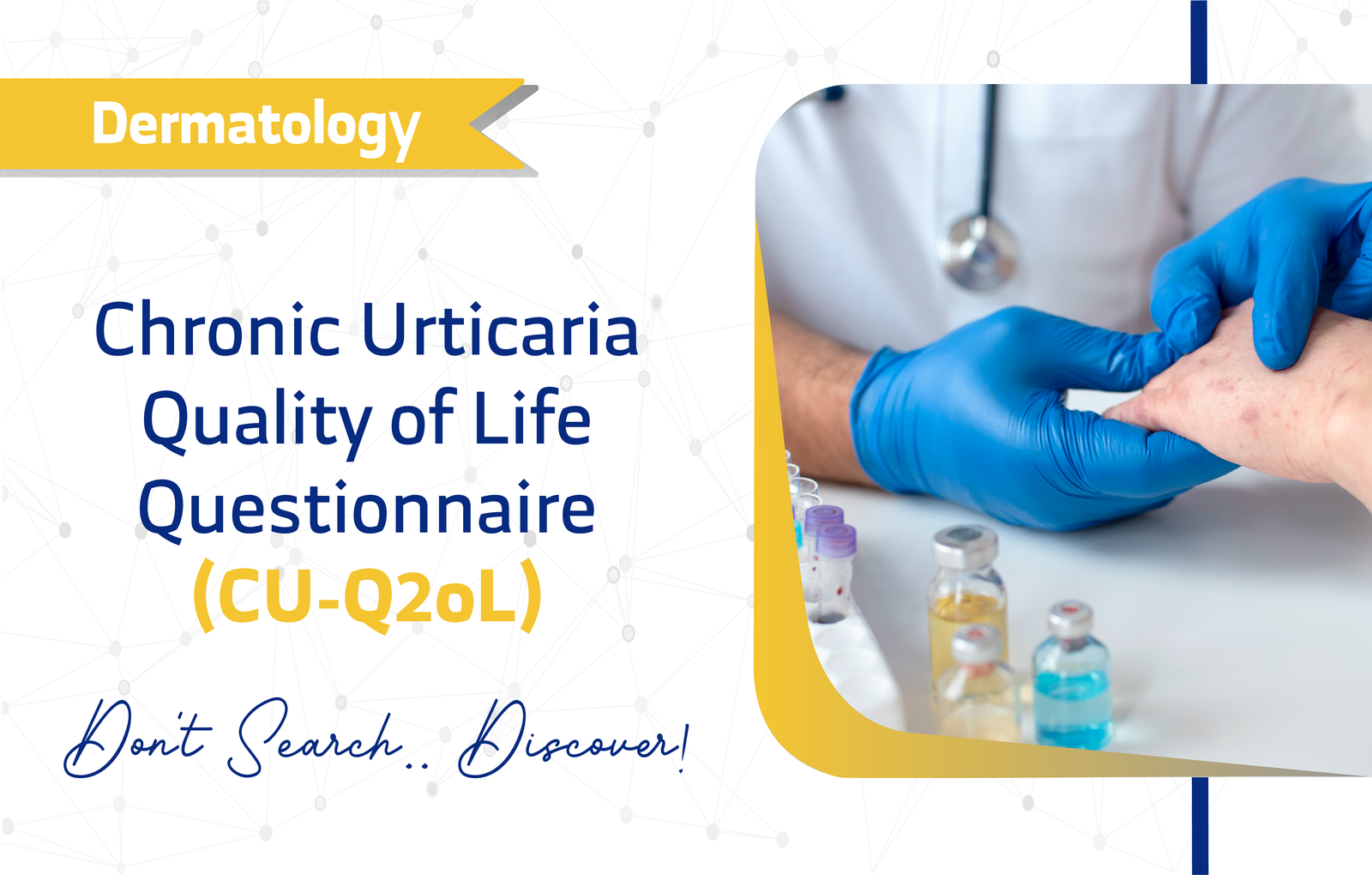Introduction
Chronic Urticaria (CU) is more than just a skin condition; its persistent itching (pruritus) and appearance of wheals and angioedema can significantly degrade an individual’s quality of life (QoL). For researchers and clinicians dedicated to understanding and mitigating the impact of CU, a robust and specific measurement tool is essential.
The Chronic Urticaria Quality of Life Questionnaire, often abbreviated as CU-QoL or CU-Q2oL, stands out as a pivotal instrument in this domain. Developed to specifically assess QoL impairment in patients suffering from chronic hives, the CU-Q2oL provides critical insights that can inform both clinical practice and research endeavors. This article offers an in-depth exploration of the CU-Q2oL, detailing its features, structure, applications, and psychometric properties, tailored for experts in dermatology, allergy, and patient-reported outcomes.
Key Features of the Chronic Urticaria Quality of Life Questionnaire
Purpose and Use
The primary purpose of the CU-Q2oL is to assess the quality of life impairment experienced by patients with chronic urticaria. This specialized focus allows for a nuanced understanding that generic QoL instruments might miss. It translates the subjective experiences of CU patients into quantifiable data, enabling researchers to track disease burden, evaluate treatment efficacy, and identify areas of patient life most affected by the condition. For clinicians, the CU-Q2oL can be instrumental in tailoring management plans and monitoring patient progress beyond just symptom counts. The questionnaire is designed to capture the multifaceted impact of CU, moving beyond purely physical symptoms to encompass emotional and functional well-being.
Target Population
The CU-Q2oL is specifically designed for adult patients aged 18 years and older who are diagnosed with chronic urticaria. This includes:
- Young Adults (18-24 years)
- Middle-Aged Adults (25-44 years)
- Older Adults (45-64 years)
- Seniors (65+ years)
While the questionnaire focuses on adults, its relevance spans across these various adult age groups, making it a versatile tool for a broad spectrum of the patient population suffering from chronic urticaria.
Structure
The CU-Q2oL is a 23-item questionnaire that comprehensively assesses the impact of chronic urticaria across six dimensions:
- Pruritus (2 items): Focuses on itching and the presence of wheals.
- Swelling (2 items): Addresses swelling around the eyes and lips.
- Impact on Life Activities (6 items): Examines how urticaria affects work, sleep, physical activity, leisure, social life, and eating habits.
- Sleep Problems (5 items): Covers difficulties falling asleep, nighttime awakenings, fatigue, poor concentration, and sleep-related nervousness.
- Limits (3 items): Assesses mood disturbances, food restrictions, and limitations in physical activities.
- Looks (5 items): Highlights concerns about visible symptoms, embarrassment, cosmetic use, clothing choices, and appearance-related medication side effects.
This structured format ensures a holistic and patient-centered evaluation of chronic urticaria’s impact.
Scoring Method
The CU-Q2oL employs a 5-point Likert scale for its 23 items, with responses ranging from 1 (“not at all”) to 5 (“very much”). The scoring process involves summing the raw scores from all items. This total summed raw score is then transformed to a scale ranging from 0 to 100. Importantly, on this transformed scale, higher scores indicate a worse quality of life. This scoring system allows for a standardized assessment of QoL impairment. Researchers and clinicians can also analyze scores for the individual six dimensions to gain more granular insights into specific areas of concern (pruritus, swelling, life activities, sleep problems, limits, and looks). Currently, specific cut-off scores for distinct levels of severity (e.g., mild, moderate, severe QoL impairment) are not explicitly detailed in the provided information.
Administration Format
The CU-Q2oL offers flexibility in administration via:
- Paper-based forms
- Digital (Online) platforms
- Interviews (In-person)
- Phone/Video Call
No special training is necessary to administer or interpret the CU-Q2oL, as it is self-administered and easily managed by healthcare staff. Administration is typically quick, estimated at 5 to 10 minutes.
Applications of the Chronic Urticaria Quality of Life Questionnaire
The AQOL demonstrates significant utility across various clinical and research settings. For instance, in clinical practice, healthcare providers can use the AQOL for:
- Screening: Identifying patients for the extent of QoL impairment at diagnosis.
- Monitoring: The questionnaire is valuable for monitoring changes in QoL over time, in response to treatment, or as the disease fluctuates.
- Treatment Planning: Insights from the CU-Q2oL can help clinicians tailor treatment strategies to address specific areas of concern for the patient, potentially improving adherence and outcomes.
Furthermore, in research, the CU-Q2oL serves as a valuable tool for:
- Quantify the burden of chronic urticaria on patients’ lives.
- Evaluate the effectiveness of new therapies and interventions in clinical trials.
- Compare QoL across different patient populations or disease severities.
Conduct epidemiological studies on the impact of CU.
Languages and Availability
Available languages include:
- Arabic
- English
- Mandarin Chinese
- Spanish
- Russian
- German
- Portuguese
- Italian
- Polish
- Brazilian
- Portuguese
- Thai
- Bengali
- Turkish
- Indonesian
Regarding access, the questionnaire is proprietary. While it is available in some clinical guidelines, it is not openly licensed. For research or clinical purposes, obtaining permission from the copyright holder or developer is recommended. Interested parties should contact Dr. Ilaria Baiardini (Email: ilaria.baiardini@libero.it) for inquiries about its use and permissions.
Reliability and Validity
The CU-Q2oL is a highly reliable and valid instrument for assessing quality of life in chronic urticaria patients. Its psychometric soundness is supported by:
- Cronbach’s Alpha: The questionnaire demonstrates good internal consistency, with a reported Cronbach’s alpha of 0.85. This value suggests that the items within the questionnaire reliably measure the same underlying construct of quality of life impairment due to chronic urticaria.
- Validation Studies: The CU-Q2oL has undergone validation in multiple languages and patient populations. Key validation studies include adaptations for Spanish, German, and Arabic-speaking populations, further attesting to its cross-cultural applicability and robustness. These studies confirm that the questionnaire accurately measures what it intends to measure. The instrument has garnered over 400 citations in Google Scholar, indicating its widespread acceptance and use in the scientific community.
Limitations and Considerations
Despite its strengths, the CU-Q2oL has some limitations that users should consider:
- Self-report measure: As a self-administered questionnaire, responses can be influenced by patient recall bias or their current emotional state. Social desirability bias, though not explicitly marked as a primary limitation in the provided table, can also be a factor in self-reported outcomes.
- Cultural Bias: While validated in several languages, there might be cultural nuances that are not fully captured, particularly with limited non-European validation being noted.
- Narrow Focus (Limited Domains Covered): Although specific to urticaria, which is a strength, it might not capture broader aspects of health-related QoL that could be relevant for some patients or research questions.
- Age Restrictions: The tool is validated for adults (18+ years) and is not suitable for pediatric or adolescent populations.
Related Questionnaires
For complementary assessments, consider:
- Dermatology Life Quality Index (DLQI): Measures broader dermatological QoL impacts.
- Urticaria Activity Score (UAS): Evaluates urticaria severity.
- Chronic Urticaria Patient Perspective (CUPP): Captures patient perspectives on urticaria management.
Additional Resources
For researchers and clinicians seeking to utilize or understand the CU-Q2oL further, several resources are available:
- Original Validation Study (Conceptual Link): The development and initial validation were spearheaded by I. Baiardini, M. Pasquali, F. Braido, et al., published in 2005. Study Link
- Access to Questionnaire Versions/Information:
- A version of the questionnaire can be found within SFDermato guidelines (page 3): Access here.
- An online survey platform related to urticaria that may utilize or reference the tool: Study Link
- Further Validation Studies:
- German version validation. Study Link
- Spanish version validation. Study Link
- Arabic version validation. Study Link
- Contact for Inquiries: Dr. Ilaria Baiardini (Email: ilaria.baiardini@libero.it).
Frequently Asked Questions (FAQ)
- Who can use the CU-Q2oL?
Clinicians (dermatologists, allergists, immunologists), researchers, and other healthcare providers use the CU-Q2oL to assess adult patients (18 years and older) with chronic urticaria.
- How long does it take to complete the CU-Q2oL?
The questionnaire is relatively brief, typically taking patients between 5 to 10 minutes to complete. This makes it feasible for use in busy clinical settings and as part of larger research batteries. - How is the CU-Q2oL administered?
Healthcare providers can administer the CU-Q2oL on paper, online, or through interviews conducted in person, by phone, or via video call. Patients can complete it on their own, and providers can guide them easily without needing special training.
- Is there any cost to using the CU-Q2oL?
The CU-Q2oL is a proprietary instrument. Researchers or commercial users generally need to obtain permission from the original developers or copyright holders before using it. Contact Dr. Ilaria Baiardini for specific licensing or permission details.
A word from ResRef
CU-Q2oL is a robust tool for assessing QoL in chronic urticaria patients, with strong psychometric properties, however it still has some limitations related to Cultural Bias (limited non-European validation) and Narrow Focus (urticaria-specific). This comprehensive overview should equip researchers and clinicians with the necessary knowledge to effectively utilize the CU-Q2oL in their practice and studies, ultimately aiming to improve the lives of patients suffering from chronic urticaria.
References
- Baiardini I, Pasquali M, Braido F, Fumagalli F, Guerra L, Compalati E, et al. A new tool to evaluate the impact of chronic urticaria on quality of life: chronic urticaria quality of life questionnaire (CU-Q2oL). Allergy. 2005;60(8):1073-8. Link
- Valero, A., Ferrer, M., Sastre, J., Bartra, J., Ortiz de Frutos, J., M老n, E., Dávila, I., & Jauregui, I. (2008). Adaptation and Validation of the Spanish Version of the Chronic Urticaria Quality of Life Questionnaire (CU-Q₂oL). Journal of Investigational Allergology and Clinical Immunology, 18(6), 426–432. Link
- Młynek, A., Zalewska-Janowska, A., Martus, P., Staubach, P., Zuberbier, T., & Maurer, M. (2009). The German version of the Chronic Urticaria Quality‐of‐Life Questionnaire: factor analysis, validation, and initial clinical findings. Allergy, 64(6), 927–936. Link
- Tawil, Samah, Abou Chacra, L., Bou Assi, T., Mokbel, M., Ibrahim, L., & El Helou, M. (2020). The Arabic urticaria activity score and chronic urticaria quality of life questionnaire: validation and correlations. International Journal of Dermatology, 59(8), 893–901. Link









2 thoughts on “Chronic Urticaria Quality of Life Questionnaire (CU-Q2oL): A Full Guide for Researchers and Clinicians”
My brother suggested I would possibly like this blog. He was once entirely right.
This submit truly made my day. You cann’t imagine simply how soo much time I had spent for this information! Thanks!
I really like looking through an article that will make people think.
Also, thank you for allowing for me to comment!